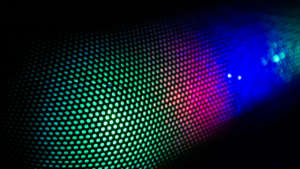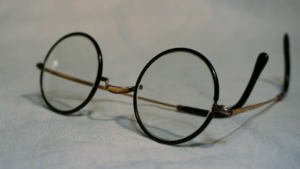What is Vision Therapy?
Vision Therapy is a specialized field of optometry that works on developing and enhancing basic visual skills, therefore allowing vision to become more comfortable and efficient. Furthermore, vision therapy positively influences vision thinking skills by improving eye-brain connections.
What We Treat
At our office, we provide treatment for a variety of vision issues through the use of specific procedures programmed by Dr. Gates. Examples of vision issues include
- Amblyopia (lazy eye)
- Strabismus (eye turn)
- Blurred or double vision
- Eye tracking or teaming
- Eye-body coordination
- Visual thinking and information processing
Before beginning therapy, Dr. Gates will perform evaluations to determine the best course of action for the patient. During a patient session, Dr. Gates and the vision therapists work together with the patients on activities that target their specific visual needs.
What Vision Therapy Can Do for You
-
- Reduce or eliminate visual deficiencies
- Improve work and classroom performance
- Aid in reading and writing skills
- Aid in perceptual skills
- Aid in attention and focusing
- Relieve symptoms like eye strain or fatigue, headaches, or stress through the use of light therapy
- Overall, improve integration of the visual system with the body and mind
How Do I Know If Vision Therapy Is Right for Me or My Child?
According to COVD.org, 1 in 10 children have a vision problem significant enough to impact learning, and normal eye screenings can miss up to 50% of visual problems. Eyeglasses, medication, and surgery can sometimes help visual issues, but are not always the answer to improving basic visual skills.

If you suspect you or your child may need vision therapy, contact our office to schedule an appointment at: https://www.visualintegrationcenter.com/request-appointment/
Explore some common symptoms caused by vision problems here: https://www.covd.org/page/Symptoms
Check out our blog post “Vision Therapy is Not Just for Kids” to learn why vision therapy can benefit everyone: https://www.visualintegrationcenter.com/vision-therapy-is-not-just-for-kids/
Irlen / Colored Lenses

What are Irlen Lenses?
The term Scotopic Sensitivity Syndrome (SSS), also known as Irlen Syndrome, was introduced by Helen Irlen, M.A., to describe a perceptual dysfunction related to “subjective difficulties with light, luminance, intensity, wavelength, and color contrast.” Essentially this means difficulty processing color and contrast changes such as black print on a white background. Irlen claims approximately 50% of the reading disability and dyslexic populations have this syndrome. According to Irlen, individuals with this condition must use more effort and energy when reading because they are inefficient readers who see the printed page differently from the good reader. She suggests a large number of these individuals can be successfully treated using tinted lenses called “Irlen Lenses.”
Irlen Syndrome or a Functional Visual Issue?
Optometrists have brought up a number of concerns about patients that are considered candidates for Irlen Syndrome. The first issue centers around the screening method used for diagnosis to determine symptoms. Results are remarkably similar to symptoms associated with a binocular vision (eye teaming), accommodative (eye focusing), and ocular motility (eye coordination) disorder as defined by the COVD Quality of Life Questionnaire. Reading symptoms associated with both Irlen Syndrome and a functional visual issue include: headaches, eyestrain, excessive blinking & rubbing of the eyes, squinting, fluctuating blur, intermittent double vision, movement of words on a page, loss of place, skipping and re-reading lines.
A study performed by Scheiman, OD et al. reported 95% of subjects identified as good candidates for Irlen filters had identifiable visual issues. However, Irlen Syndrome is described by Irlen advocates as a diagnosis unrelated to any visual issue. Attempts have been made to direct Irlen candidates to an eye examination prior to Irlen diagnostic testing. The study by Scheiman, OD et al investigated this and found 57% of their subjects had some form of eye care and were told their vision is “normal” in spite of binocular vision (eye teaming), accommodative (eye focusing), and ocular motility (eye coordination) issues being present. This is where a referral to an appropriate vision care provider is important. Unfortunately some eye care professionals are not including binocular, accommodative and oculomotor testing into their eye examination and without testing for these visual issues, individuals will not receive the necessary vision therapy to address their problems.
The Need for a Functional / Binocular Vision Examination and Vision Therapy
From this research it’s evident many individuals with undiagnosed functional-based visual issues are seeking treatment with Irlen filters. These patients need a proper binocular vision examination to rule out visual issues that are likely interfering with school and life. Another study by Blaskey, Scheiman, et al identified all subjects in the Irlen filter subject group reported a reduction in symptoms and improved comfort, however they still had “clinically significant vision anomalies after treatment with Irlen filters.”
This study also included subjects treated with Vision Therapy and found significant overall improvements to the extent that those who were previously determined as a candidate for Irlen lenses (by Irlen survey), then scored below the level where they would be considered a candidate.
Another interesting finding reported was a combination of Irlen filters after successful Vision Therapy resulted in additional benefits. The reason for this remains uncertain, but this details the importance of collaboration among health care professionals ensuring the child/patient receives the best care possible.
How our Examinations are Different
At Nebraska Visual Integration Center we see patients for a myriad of functional-based visual issues. These visual issues are often not identified during a routine or general eye examination. A general eye examination will typically consist of an assessment of eye health and eye sight. These are two very important aspects of vision care, but further testing is needed to determine performance of the visual system and how it can impact classroom performance. Deficits in binocular (eye teaming), accommodation (eye focusing), and oculomotor coordination (eye control) must be identified. At our office we are dedicated to providing the best functional vision care to allow each patient to perform at their maximum potential in school, work, and life.
How Can we Help?
Please contact our Omaha Vision Therapy office at (402) 502-0043 or email: admin@visualintegrationcenter with any questions. More information can be found at our Website and Facebook. We’d be happy to explain how our process of vision care is different and how we can help you / your child.
We all can benefit from more efficient vision.
Certain individuals will especially benefit from this type of care such as:
- Those who use their near vision a great deal at work or school such as those that spend many hours every day on a computer, reading small print, examining small objects, ect.
- Students who have been diagnosed as ‘learning disabled’
- Athletes
- Individuals who have suffered from brain injury or other head trauma
- People who are myopic (nearsighted), hyperopic (farsighted), have astigmatism, and/or have presbyopia (similar to farsightedness that begins usually after the age of 40)
- Anyone interested in improving their vision naturally
Will I have to do vision therapy forever?
No. Once your eye muscles and visual system have been reeducated, they remember their new skills and automatically use them all the time.
Can I wear glasses to avoid vision therapy?
Usually, no. This is not a seeing or eyesight problem, but an eye muscle problem –a problem controlling the eye muscles that usually can’t be helped by eyeglasses alone.
What is computer vision syndrome (CVS)?
It’s a condition recognized by the American Optometric Association that affects users of computer monitors and causes eye strain symptoms, such as blurred vision, dry or burning eyes, delayed focusing and headaches. It can arise from failure of the eye muscles to work properly.

Vision therapy –like a physical therapy for the Eyes and Brain
Vision Therapy is a highly effective non-surgical treatment for many common visual problems such as lazy eye (amblyopia), crossed eyes (strabismus), double vision, convergence insufficiency and many reading and learning disabilities. Many patients who have been told, “it’s too late” or “you’ll have to learn to live with it” have benefited from vision therapy. Eyes that are too tired to read after dinner, feeling sleepy when reading, reading too slowly and afraid to drive at night are just a few of the many reasons adults decide to improve their vision through vision therapy.
Feeling eyestrain and the need to do visual exercises is becoming more relevant these days with the dramatic onset of computer use, and overall close-up work required daily for students and professionals. Visual exercises help maintain healthy vision, reduce or eliminate the effects of eyestrain, and ultimately help to preserve eyesight. In the case of learning disabilities and attention problems, vision therapy is specifically directed toward resolving visual problems that interfere with reading, learning and educational instruction.
What is accommodation?
The ability of the eyes to focus clearly and sustain focus on objects of various distance.
What is convergence?
The aiming of the eyes inward toward an object.
What is fusion?
The process by which what is seen separately, by each eye, is integrated into a single perception.
What is stereopsis?
The learned ability to perceive relative depth– due to each eye having a different vantage point– commonly called 3D vision or depth perception.
Is Eye Strain from Binocular Vision Problems related to Learning Difficulties?
Often, yes. Children who tire easily from eye muscle problems have a greater workload when reading or using a computer. This additional load may make it harder for them to learn. Read more on our Vision and Learning page.
What is vision therapy?
Vision Therapy it is a program of therapeutic activities designed for improving visual function including eye movement coordination, accommodation (eye focusing), binocular fusion (eye teaming) and visualization. It works on the eye-brain connections involved in visual coordination and visual processing and consists of a series of visual, and visual sensory-motor activities of progressive difficulty, performed several times a week until symptoms are resolved and a more efficient visual system is developed.
Who needs vision therapy?
People who have eye muscle problems that cause eye strain symptoms- such as blurred vision, headaches, fatigue, concentration difficulty- including computer vision syndrome and vision-related learning problems as well as people who want to get more done with less energy, less effort, and more efficiency.
Why does this happen?
Our eyes are not made to fixate on two-dimensional written pages or computer screens for hours at a time. Our eyes are more geared for distance vision activities, and the constant demand of near work puts stress on the eyes leading to a less than efficient visual system.
How much time do I have to spend doing vision therapy?
That depends on how quickly your eye muscles and your visual system can learn the needed skills. A Vision Therapy treatment program can last anywhere from a few months to nearly a year depending on the severity of the vision problem as well as patient motivation and compliance. In most cases, significant benefits can be seen in a less than month.
At Nebraska Visual Integration Center we dedicate all of our time in helping patients of all ages with visual issues that impact their lives. We are proud to offer Vision Therapy to the Omaha, Council Bluffs and surrounding metro areas. Please contact our office at (402) 502-0043 or email [email protected] with any questions or to see if an evaluation is necessary to determine if Vision Therapy can help you.
This article is adapted from Learning Magazine
Written By: Mitchell Scheiman, OD, FCOVD
Richard, a 12-year old in your 7th grade class, is a verbal child. From what you’ve seen early in the year, you expect him to be an above average student. But gradually, you realize that he is struggling just to maintain average grades. Looking at his past records, you see the same pattern: strong language and verbal skills, but marginal performance. As you try to figure out what could be wrong, you notice that Richard is easily distracted. He almost never completes in-class silent reading assignments and consequently does poorly on answering the follow up questions. On homework, if the task is creative writing, he does well. But if he has to read for understanding, he seems lost.Watching more closely, you also notice that Richard often rubs his eyes when he’s reading. Sometimes he complains that he has a headache or tired eyes.
Visual Efficiency Problems
Richard’s behavior is characteristic of a child with an undetected vision problem. And there are many Richards. Experts estimate that 10% to 15% of school-age children have vision problems significant enough to interfere with academic performance. For children with learning problems, the figures are as high as 30% to 60%. And many of these children have passed the annual school vision screening with flying colors.Do you have a student with an undetected vision problem? The charts on the next two pages may help you discover why a student you think should be doing fine is failing. If one of your students exhibits some of these symptoms, make sure he gets tested by a professional as soon as possible. Help that could dramatically improve his school performance is available.These kinds of sight problems interfere with a child’s ability to clearly and comfortably see and take in information for sustained periods of time. Many of these problems don’t surface until the upper elementary grades or junior high, when children are required to cover significantly more reading material. Visual efficiency problems include nearsightedness, farsightedness, astigmatism, and problems with focusing, tracking and eye teaming. Nearsightedness is the condition most commonly detected by the traditional school vision screening. But nearsighted children tend to be some of the best readers, and the traditional screening doesn’t necessarily identify any of the other problems.
Vision and Learning
Most people think that a child who has passed the annual school vision screening has “good vision” and can see the board and his textbooks clearly.Unfortunately, this is a serious misconception because the traditional school eye exam doesn’t test aspects of vision required for reading. And sadly, the perception that everything’s okay can mask significant learning-related vision problems.The key to understanding the relationship between vision and learning is realizing that vision is more than just being able to see the letters on the 20/20 line of a chart placed 20 feet away. Visual problems can be divided into two broad categories – visual efficiency and visual processing.
Nearsightedness (Myopia)
The inability to clearly see things in the distance
Symptoms:
- Squints
- Gets close to board
Farsightedness (Hyperopia)
The inability to clearly see closeup things
Symptoms:
- Rubs eyes
- Has watery eyes
- Complains of blurred vision
Astigmatism
This condition causes blurred vision for distant and closeup things
Symptoms:
- Complains of blurred vision
- Holds book at close distance
Eye Teaming disorders (Binocular Vision)
A variety of conditions in which the eyes tend to drift inward, outward, or upward
Symptoms:
- Has intermittent double vision
- Closes or covers one eye
- Says letters or words appear to move
- Loses place
- Is inattentive
- Rubs eyes
- Has watery eyes
- Has poor reading comprehension
Eye Focusing disorders (Accommodation)
The inability to contract or relax the eye focusing muscles to allow for clear, stable vision
Symptoms:
- Has blurred vision when looking from board to book or book to board
- Holds things very close
- Has headaches when reading
- Is tired at the end of the day
- Is inattentive
- Rubs eyes
- Has watery eyes
- Complains of blurred vision
- Has poor reading comprehension
Eye Tracking disorders (Saccadic Dysfunction)
Inadequate ability to scan along a line of print and move the eyes from one point in space to another
Symptoms:
- Moves head excessively when reading
- Loses place frequently
- Skips lines when reading
- Uses finger to keep place
- Has poor reading comprehension
- Has short attention span
Visual Processing Problems
These problems have to do with the child making sense of incoming visual information. They include difficulty with laterality, directionality, visual form perception, visual memory, and visual motor integration.In contrast to visual efficiency disorders, many of which surface in the middle grades, visual processing problems tend to sabotage learning for children in the early grades even kindergartners. Children with visual processing problems may be difficult to teach because they fail to understand and grasp basic concepts and ideas.
Visual Issues Impact Learning
Directionality and Laterality Problems
Poor development right/left awareness
Symptoms:
- Has trouble learning right and left
- May read either left to right or right to left
- Reverses letters and words
- Has trouble writing and remembering letters and numbers
Faulty Visual Form Perception
The inability to discriminate among different shapes
Symptoms:
- Confuses likenesses and minor differences
- Mistakes words with similar beginnings
- Can’t recognize the same word repeated on a page
- Can’t recognize letters or even simple forms
- Can’t distinguish the main idea from insignificant details
- Has trouble learning the alphabet recognizing math facts, and learning basic math concepts of size, magnitude, and position
Faulty Visual Memory
Inability to remember what is seen
Symptoms:
- Has trouble visualizing what is read
- Has poor comprehension skills
- Has trouble learning new material
- Is a poor speller
- Has poor recall of visually presented material
- Has trouble with tasks that require more than one step
- Has trouble with math concepts
- Has trouble with sight vocabulary
Faulty Visual Motor Integration
The inability to process and reproduce visual images by writing or drawing
Symptoms:
- Has sloppy writing and drawing skills
- Can’t space letters or stay on lines
- Has poor copying skills
- Erases excessively
- Can respond orally but not in writing
- Seems to know material but does poorly on tests
Treatment
A full evaluation by a professional who has the expertise to test for both visual efficiency and visual processing disorders is the only way to detect some vision problems. When one of these hidden problems does exist, treatment involving eyeglasses, vision therapy, or both can correct it. Glasses are generally effective for nearsightedness, farsightedness, and astigmatism. They can also correct some types of focusing and eye teaming disorders. In fact, 85% to 90% of people with vision problems are treated with glasses. However, the other 10% to 15% require vision therapy. This therapeutic approach involves a series of treatments that includes using special instruments and activities under close supervision.The education and clinical training of optometrists stresses both eye health and eye function. This makes them uniquely qualified to detect and treat vision problems that interfere with school performance.To find an optometrist qualified to treat learning-related vision problems, visit the College of Optometrists in Vision Development (COVD) at www.covd.org. COVD can provide a list of its fellows in any area of the United States.It is important to understand that optometrists don’t specifically treat reading or learning problems. But along with extra help or tutoring from parents and teachers, an optometrist can correct the vision problems that may be blocking the possibility of learning.
Nebraska Visual Integration Center is a Vision Therapy office in Omaha, Nebraska that specializes in the diagnosis and treatment of visual efficiency (visual skills) and visual processing issues that impact school and learning. If you think you or your child may have a hidden visual issue impacting learning, please contact our office at (402) 502-0043 or email at [email protected]. We enjoy seeing lives change by taking care of visual issues that block learning and we would love to help you.
How Accurate are Vision Screenings?
If you have a child in school they have probably had a vision screening. These are generally performed by a pediatrician, or a nurse if done at school. It’s important to note that these are rarely performed by a vision specialist or optometrist. A vision screening is usually part of a school general physical. This is an opportunity to note any physical issues and may lead to a referral to an eye doctor, although they do not offer a diagnosis or treatment plan.
The Good and Bad of School Vision Screenings
The American Optometric Association says:
- Schools screenings provide <4% of the vision tests needed to help a child see.
- Miss up to 75% of children with vision problems.
- Of the children found to have eye problems through screening, 61% never visit the eye doctor.
School vision screenings are limited, but are typically able to detect issues such as myopia (nearsightedness) and amblyopia (lazy eye). Amblyopia is a visual issue that requires an optometrist with specialty training. Vision screenings often fall short diagnosing visual issues that have an impact on learning, reading and classroom performance. Issues like hyperopia (farsightedness), binocular vision (eye teaming) disorders, eye tracking and eye focusing can have a significant impact on visual functioning for learning.
What to do after a Vision Screening
Your child has had a vision screening so what now?
If your child has failed any portion of the vision screening, it’s necessary for them to see an optometrist or other eye care specialist. If there is suspicion of a visual issue impacting learning, your child may likely need to see an optometrist who specializes in vision therapy and binocular vision. Optometrists who specialize in treating visual issues that affect learning are called developmental or functional optometrists.
What does a Developmental Optometrist Do?
A developmental optometrist specializes in vision therapy. Vision therapy has been scientifically proven to treat and remediate a number of learning-related vision issues. COVD is a website dedicated to the advancement of vision therapy and the prevention, enhancement, and rehabilitation of functional visual issues.
Below you’ll find the full article on vision screenings and how they are insufficient in detecting a number of significant visual issues.
